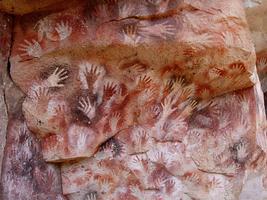The Hairy Origins of Screen Printing
By: Rachel T, rachel.t@annarbortees.com
almost 7 years
Screen printing is the process of pushing ink through a mesh screen to create a print. A stencil of the design blocks off some of the ink in the shape of the desired print. This basic technique has changed little over the course of thousands of years. Yet, major technological advances helped printers adapt to a growing demand.
Both the use of stencils and the creation of printed images are some of the oldest forms of human expression. Some span all the way back to 40,000 BCE. Researchers have found examples of prehistoric art in countries around the world. This includes France, Spain, Australia, South Africa, Turkey, Indonesia, and Belize. It is no wonder then that printed images are still used in so much of our daily lives.
How did printing begin?
Oftentimes, our ancient ancestors made images on the surface of cave walls using nothing more than their hands. They created these prehistoric designs as either a print or a stencil. The prints, known as “Positive Handprints” were usually red, white or black pigment that coated the artist’s hand. The artist then pressed the pigment coated hand against the surface of a rock, leaving a rough handprint behind. Ancient artists created the stencil version or “Negative Hand Stencils” by first laying their hand on a flat surface. They then sprayed over the hand and surface by blowing pigment through a reed or bone, or even spitting it from their mouths. This method left behind an outline of the hand.
What about screen printing?

The original ink printer?
Early examples of printing with small seals and stamps exist in China, Mesopotamia, and Egypt. However, China boasts of the origin of screen printing during the Song Dynasty (960-1279 CE). A wooden frame and human hair for mesh composed the first printing screens. Hair was strong enough to hold a stencil in place. Hair was also fine enough to allow the colored vegetable dyes and pigments to pass through the unobstructed spaces and onto the substrate. The substrate is the fancy industry term for whatever needs printed on.
China eventually improved on these hairy screens with their most precious secret, silk. Read on to our next blog, For Their Dyes Only: the Secret of Silk, to learn about the importance of silk in ancient China and the origin of silk screening.
Or is that enough lesson time? Ready for your own custom shirts?
I'm Ready. Let's Do It!References
- http://www.ooshirts.com/guides/History-of-Screen-Printing.html
- http://www.visual-arts-cork.com/prehistoric/hand-stencils-rock-art.htm
- http://www.brighthub.com/multimedia/publishing/articles/105324.aspx
- http://revolverwarholgallery.com/andy-warhol-screenprints-process-history/
- https://www.dfcscreenprinting.com/blog/the-history-of-silk-screen-printing.html
- http://www.visual-arts-cork.com/printmaking/screen-printing.htm
- https://en.wikipedia.org/wiki/Silk
- https://en.wikipedia.org/wiki/Screen_printing
- http://www.gwent.org/gem_screen_printing.html#history
- Mental Floss History of the World
- https://en.wikipedia.org/wiki/Mimeograph
- http://homepage.usask.ca/~nis715/scrnprnt.html
Tags: #screen printing, #learn about printing, #history


